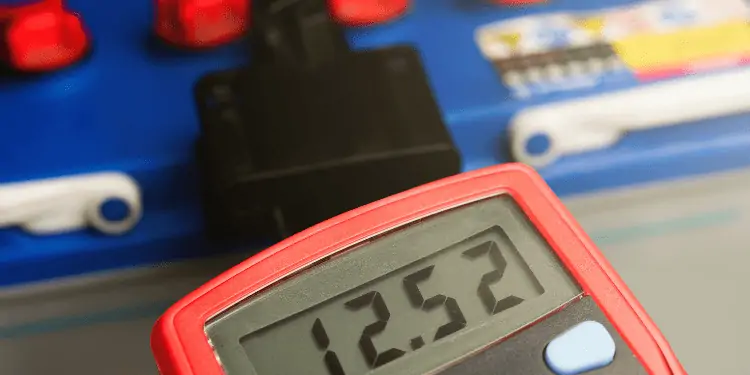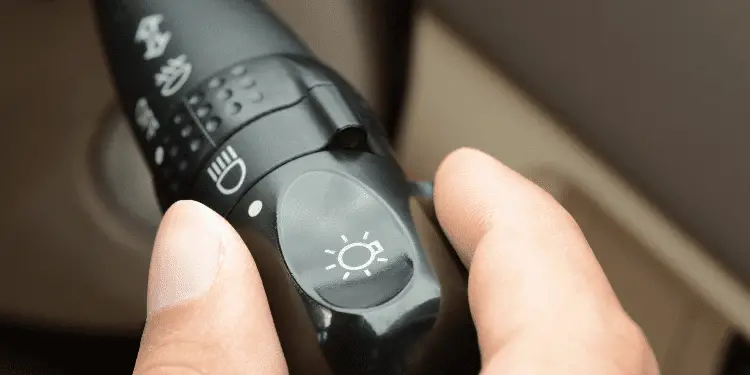Here we’ll look at the different situations that may make your car battery gauge read low.
Your car volt gauge should show a different voltage reading in different circumstances, and here we’ll explore them.
Most car voltmeter gauges have a center point of 12 volts. That’s a good starting point for this article.
Where Should The Needle Be On A Battery Gauge?
A fully charged battery should show a reading of 12.5 volts when you turn the key in the ignition but don’t switch it on. Anything below this indicates your battery’s health may be poor.
Once you turn the key and start the vehicle, the reading should increase to 14 to 14.5 volts. This shows that the battery is charging efficiently from the alternator.
If this reading stays at 12.5 volts or dips below, that is an indication that either the battery isn’t capable of being charged by the alternator or that the alternator cannot charge the battery. If this continues, eventually, the battery will die.

In this situation, it is more likely to be the alternator. This is because the battery did its job when you initially turned the key halfway. The low reading has only shown once you’ve asked the alternator to charge the battery,
It would be unwise to change your battery or alternator based on what the voltage on the cluster is showing you because they occasionally go wrong.
You need to confirm the voltage by doing a manual check yourself.

If you don’t have a voltmeter, you can buy one for around $20 or take your car to a car shop to test the battery. If you have one, do these checks to confirm the battery’s and alternator’s health.
- With the car off, expose both battery terminals – they are often protected by plastic casing that can be pulled up and back from the terminals. Before going any further, inspect the condition of the terminals – do they appear corroded? Are the leads attached securely? If not, you may have identified the problem right there.
- Set the dial to 20 – You’ll see it in the DCV section of the dial. This will allow you to measure voltage between 0 and 20 volts accurately.
- Your voltmeter has two probes – hold the red lead to the positive and the black to the negative. It doesn’t matter in what order you do this. If you get a minus reading, this indicates the probes are the wrong way around.
- You are looking for a reading of 12.6 v here. Even a slightly lower reading indicates a significantly undercharged battery. In fact, 12.2 v shows that the battery is only 50% charged.
- Next, start the car and take another reading. Now you want to see 13.7 to 14.7 volts. This reading shows that the alternator is charging the battery. If you don’t see this increase, the alternator is not working well.
How To Check Car Battery Voltage Without A Voltmeter
If you don’t have a voltmeter and either don’t want to spend the money on one or need to know right now whether it’s bad, do this check:
- Start the car and turn on the headlights. If they’re not bright, this could indicate that your lights are not running off the alternator power but the battery.

- Now press on the gas pedal and increase the revs. Do your lights get brighter or stay the same? If they get brighter, your alternator is at least providing some charge to your electrical system. If the brightness stays the same or diminishes, this indicates your alternator is faulty.
If the lights are bright, then revisit the battery terminals. I would always clean them up before changing the battery.
A new battery will cost $100 +, but for the cost of a can of battery cleaner – approx $10 – you might save having to buy a new one. If your battery is in good condition, it may still have issues receiving the charge from the alternator.
Many visitors also read this article: What Causes Stalling After A New Battery Is Fitted?
Mechanics often use grease to improve conductivity, but a can of Battery Terminal Protector can work just as well and might fix a low voltage problem.
Battery Voltage Low Only In The Morning
This can cause a lot of stress. Never knowing when you turn the key if there is going to be enough voltage to start the car is worrying. Cold weather can drain the charge from a battery, but often there is another cause, and it’s not the battery’s fault.
It’s not unusual for car owners to replace their battery twice in a few months, thinking that the battery is bad when in fact, there is something else causing the battery to lose its charge.
Parasitic Draw or Parasitic Drain
Electrical components can take charge away from the battery when your car is off.
Think of it as leaving your car lights on by mistake overnight. Now, the charge taken from the battery will not be as much as this, but if every night the battery is drained a little every time, it won’t be long until the battery is operating at or around 12.2 volts – half its designed charge.
This can be especially true if you only make short journeys each day as the alternator is not getting a chance to recharge the battery.
Many visitors also read this article: Can Leaving Car Lights on Auto Drain The Battery?
Test For Parasitic Draw
- There is no way of getting around it; you’ll need a multimeter for this test and access to your car’s fuse panel.
- Now you need to open all the doors, the hood, and the truck and lock manually by placing a screwdriver in the mechanism and pushing down. We want the car to be sent to sleep but have access to all doors at the same time.

- With the doors, hood, and trunk left open, lock the car with the remote and leave it alone for ninety minutes or more.
- Return to your vehicle and use a multimeter to test each fuse in the panel. Turn your multimeter to Mv – millivolts – and place the probes on both parts of the fuse metal tips on the housing. You are looking for no reading, but if you see one reference to the Power Probe chart to see the amps the system is taking out of your battery.
- Finding a draw doesn’t stop the offending component from continuing its draw, but it allows you to troubleshoot that circuit with certainty – rather than guesswork.
- Some people pull fuses and see if there’s a change in the voltage reading at the battery. This option is not as exact as this method, although it is quicker.
In Conclusion
A reading of 12 volts or less on a numerical gauge when the engine is running implies a charging fault. Above 13 and below 15 volts is normal. Readings over 15 or even below 13 volts signal a problem with the alternator or a battery that isn’t holding a charge.
Never take the voltmeter gauge reading as 100% correct; always do a manual check to confirm.
Your car battery should read 12.6 volts with the key turned but without the engine on
The car battery should read between 13.7 and 14.7 volts when the engine is on.
Any lower readings indicate a problem with the battery or alternator.













